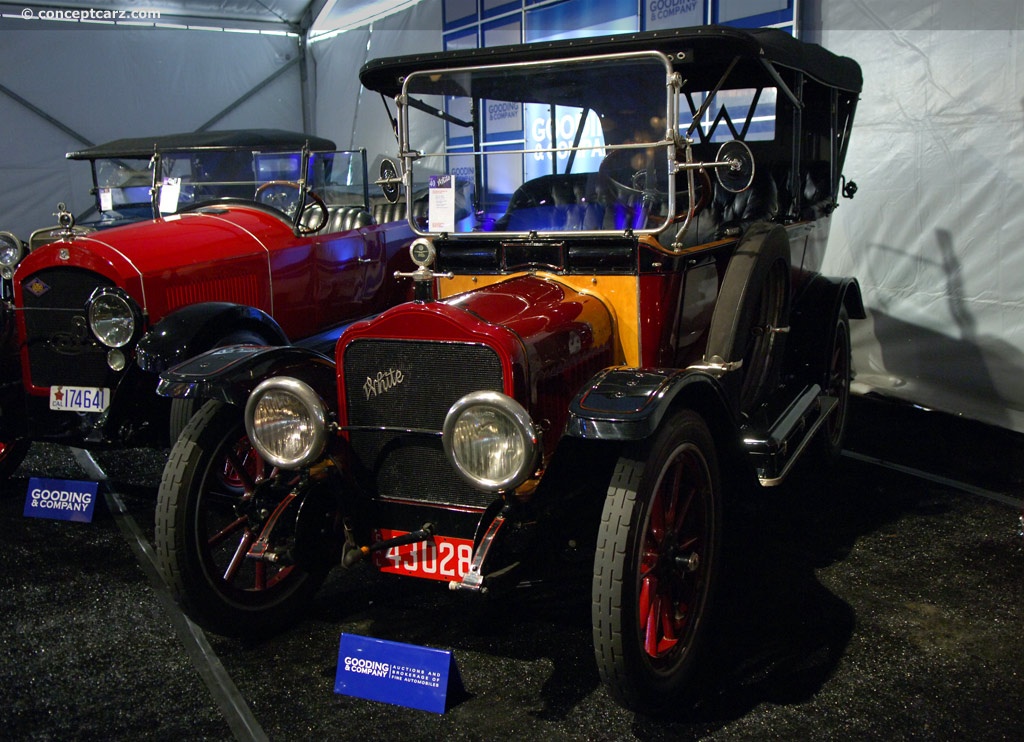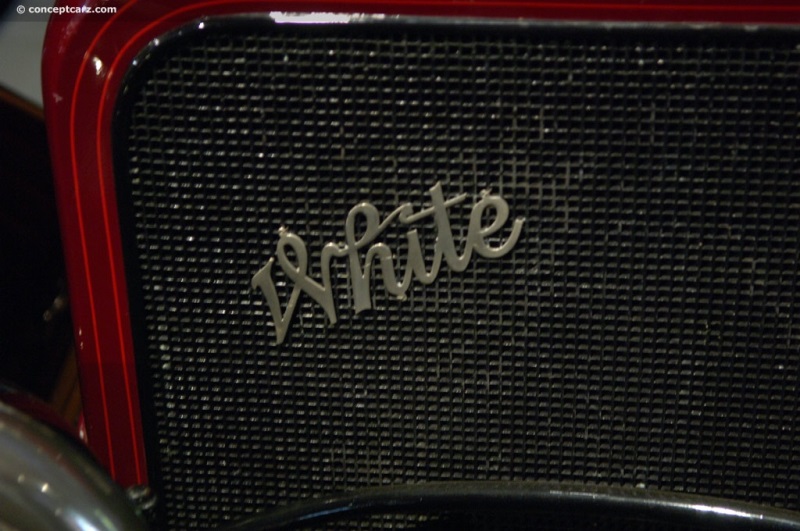1914 White Model Thirty Navigation



Touring Car
Chassis #: 20688
Engine #: GK 2637
Sold for $29,700 at 2018 RM Auctions : Auburn Fall.
The White Company, under the direction of Rollin H. White, built their first steam-powered car in 1900. The following year, 193 examples were built and sold. Innovation and modernization continued throughout the years, with the buggy-styled body being replaced by a front-mounted compound engine design in 1903. The design featured wheel steering, shaft drive, and an armored wood frame. Some of their cars were given 2-speed rear axles and by 1909, some were produced as much as 40 horsepower. During the Theodore Roosevelt and William Howard Taft presidential era, White's were the official White House cars. The White steam cars were catalogued until 1911, after which their entire production was changed to internal combustion engines beginning in 1910. Their engines had four cylinders in an L-head monoblock design with the cylinders cast in pairs. They were mated to a four-speed gearbox with an overdrive top ratio.A few years later, in 1912, a six-cylinder engine was added to the line-up and continued through 1916. The following year the four-cylinder engines had four valves per cylinder. At this point in history, trucks were more popular than automobiles for the White Company. After 1918, White automobiles could be ordered by special order only.
In 2007 this 1914 White Model 30 Touring Car was brought to the Gooding & Company auction held in Pebble Beach, California where it was estimated to sell for $75,000 - $95,000 and offered without reserve. Bidding failed to reach the estimates, but since there was no reserve, the lot was sold. It sold for $57,200 including the buyer's premium.
By Daniel Vaughan | Apr 2008
In the early days of automobile production, there were three main power sources to drive the vehicle: gasoline, electricity, and steam. All three had 'pros' and 'cons', with gasoline eventually becoming the more popular around 1914. During the late 1890s and early 1900s, it was unclear which would have become the dominant source. Gasoline was smelly, noisy, and difficult to start, though it was the most powerful. Electricity was the popular choice for city driving, especially with doctors and ladies. It was quiet and clean but it had a limited distance that it could travel and replenishing its power took time. Steam was quiet and clean but it had its drawbacks. The vehicles produced a lot of heat, and it took a while to produce steam. This meant that the driver often had to wait 30 minutes or more for the vehicle to be ready to drive. Water was inserted into a boiler and then heated from either gasoline or kerosene. The steam was then sent to the cylinders causing pressure that drove the pistons. The steam was condensed, changing steam back into a liquid form. The water was then reused. Rollin White of the White Sewing Machine Company in Cleveland was a strong believer in the future of steam-powered automobiles. He created an engine that was easy to operate and durable. In 1899 he patented his 'semi-flash boiler' which provided safety features that were revolutionary at the time. Boilers were often prone to explosion, but with Rollin's design, these problems were virtually non-existent. Other steamers heated the water in the upper coils but Rollins allowed the water to be heated in the lower coils. This meant that the generator was able to produce steam more quicker and safer.
By 1906 the sewing machine company and automaking department had become separate, with Rollin and Windsor White in charge of the automobile production. A few years later, in 1910, the White Company began producing gasoline-powered cars. Their business was 50 percent steam and 50 percent gasoline production. The following year would be the final year of steamer production and by 1912 the White Company was only producing gasoline-powered vehicles. During its eleven years of producing steam-powered vehicles, 9,122 examples were produced. In 1912 the controls of the White automobile shifted from the right-hand side to the left. Much experimentation followed with the gasoline engine. By 1912 the company was using a variety of four and six-cylinder engine to power its machines. The majority of the vehicles used the four-cylinder with a total of 432 examples being powered by the sixes. In 19114 Thomas White passed away; that same year Rollin severed his ties with the company. Windsor White became president and Walter White was elected as vice president. After this reorganization, the company officially became known as the White Motor Company in 1915.Leon Rubay was hired in 1915 to head the Pleasure Vehicle Department. Rubay was a prominent auto body manufacturer who had a profound effect on the White vehicles creating superior styling and bodywork for the White passenger cars. Rubay stayed with the company for only a year but his influences were profound. After Rubay's departure, he created his own manufacturing company which White continued to use to body their most luxurious automobiles.The trucks that were built by White were used during World War One. Prior to the Russian Revolution, the Czarist purchased a fleet of White trucks, which came to be known as 'the White Squadron'. After 1918 White abandoned car production and focused solely on trucks. The company had produced 8,927 examples of gasoline-powered cars. The company continued to produce trucks becoming one of the largest producers in America. In 1980 they went bankrupt and were later absorbed into Volvo/GMC, later Volvo North America.
By Daniel Vaughan | Apr 2008
White turned out 719 steam-powered model Ds and one, outlined with electric lights, was suspended from the ceiling at the Cleveland Automobile Show in 1904. White gave out white carnations and hat pins shaped like the little 1904 White Model D to all female visitors to the show.
By Daniel Vaughan | Apr 2008
- 1914 White Model Thirty Menu
- Article
- Image gallery
- Valuation
- Specifications
- Profiles
White
Similarly Priced Vehicles
- Westcott Model 6-50 ($2,480-$2,540)
- Benham 6-48 ($2,485-$2,535)
- Marmon Model 41 ($3,000-$3,300)
- Rauch and Lang B4 ($2,950-$2,950)
- Mercer Model J-35 ($2,600-$2,600)
- Franklin Model 6 ($2,300-$3,400)
- Rauch and Lang Model R ($2,600-$2,600)
- Cadillac Model 30 ($1,930-$3,223)
- Detroit Electric Model 47 ($2,850-$2,850)
- Mercer Model O ($2,900-$2,900)
- Case Model 40 ($2,300-$2,500)
- Franklin Model M Series 5 ($2,900-$2,900)
Average Auction Sale: $43,450
1914 White Model Thirty Vehicle Profiles
Recent Vehicle Additions
Performance and Specification Comparison
Price Comparison
Model Thirty Specification Comparison by Year
Year
Production
Wheelbase
Engine
Prices
Related Automotive News

Techno Classica 2014: more than 30 racing cars to celebrate 120 years of Mercedes-Benz motor racing history
Cars that were the heroes of magical moments put their stamp on this high-powered, most comprehensive show presentation
With more than 30 vehicles, Mercedes-Benz Classic presents motor racing history in all its unique breadth and depth
120 years o...

Magic moments: 120 years of Mercedes-Benz motor sport: history at the Retro Classics show from 13 to 16 March 2014
Mercedes-Benz Classic presents highlights in the history of the DTM in hall 7 at the show in Stuttgart
Strong presence by the company and the brand clubs at southern Germanys leading show for automotive classics
Fascinating dialogue between compe...

Mercedes-Benz Classic at the 2013 Pebble Beach Concours d'Élégance
Mercedes-Benz Classic brings Prinz Heinrich Benz and 2440 hp Benz landaulet to California
Representatives of the brands long tradition of sports- and luxury-class cars
Stuttgart – Mercedes-Benz Classic is to mark its attendance at the Pebble...

FULL STEAM AHEAD FOR HISTORICS
Stanley Steamer takes centre stage for spring sale
Brooklands will provide the backdrop for the ultimate MPV – built long before the category was even invented – when a 1917 20hp Stanley Mountain Wagon crosses the block on Saturday March 9t...

The Champion in Touring Car Racing : The BMW M3
In August 1985, a rumour surfaced in motor magazine Auto-Deutschland which emanated from a new sports car. An A Group Car from BMW that was a thoroughbred racing car according to the rules but was also to be produced in a version licensed to drive on...








